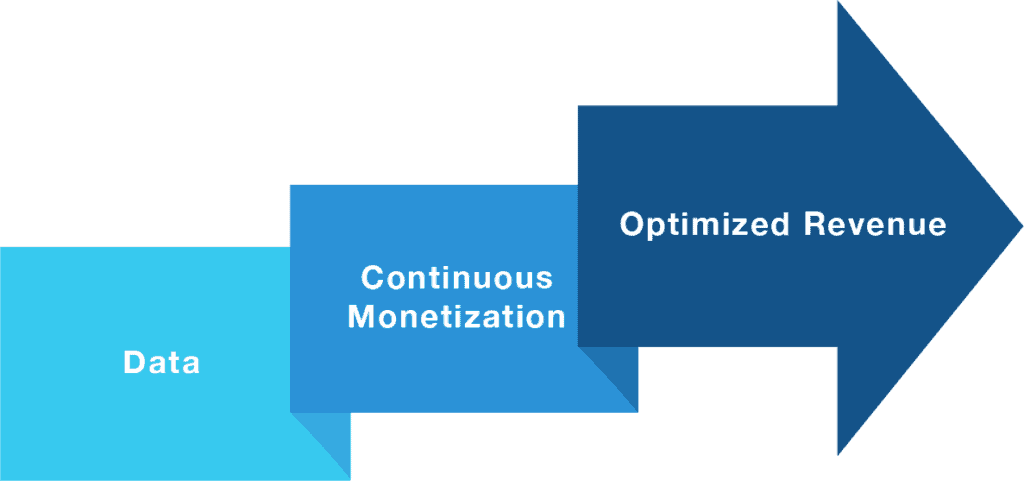There is a myth about pricing that software companies often let themselves believe. It involves the notion that once a customer purchases their software, the ongoing monthly price entitles the customer to all the new features and value of the product going forward. That’s the win-win beauty of the SaaS model, right?
The problem is that improvements and additions the company makes to its software can drastically alter the cost-value calculus. Over time, the amount the customer pays drifts out of sync with the value the software delivers. This usually leaves the software company on the short end of the deal, with revenue still on the table.
Rather than accept this myth, top performing software companies set off on a constant hunt to get paid fairly for their intellectual property. They know that the never-ending development of a software product means that, over time, some elements will over-deliver value to their customers while others may be underused, so they persistently monitor the value drivers and adapt their pricing.
We call this Continuous Monetization, and it is a critical contributor to price optimization and the software company’s long-term success and valuation.
What is Continuous Monetization?
Continuous Monetization is a pricing optimization technique by which B2B software companies continually optimize all aspects of how they license, package and price their software products and related services. It is a crucial component in pricing optimization because software products often mature to provide additional value beyond the initial fees paid by customers. Note that Continuous Monetization is not the same as Continuous Pricing, which is a term for dynamic pricing that adjusts moment-by-moment based on supply and demand, such as those used by airlines.
Pricing Optimization is best discovered inside-out, not outside-in
The software industry is, of course, unique in many ways. For pricing strategists, this plays out within the nuances and variables of software development. When a consumer decides to buy a new refrigerator, for example, they have a pretty complete idea of its value. While certain features and designs or even brand strength can affect that value, the buyer can make an easy price comparison because of the product’s functional parity with other offerings—generally speaking, an icemaker is an icemaker. This creates an emphasis on “Outside-In” pricing, where the customer’s perceptions of value become a large contributor to the product price.
That’s not the case in software, where customer perceptions of value can miss the subtle distinctions that create huge differences between seemingly similar products. The variability in user experience, scope, flexibility, scalability, integration and many other attributes can completely change a product’s value from one customer to another. There is minimal functional parity in software—an email capability is not an email capability. So, rather than view pricing as an outgrowth of customer perceptions of value, an “Inside-Out” perspective that accounts for how customers actually use and derive value from the product is often more appropriate.
Yet when you’re playing an unconstrained game of innovation, where the product is constantly changing, how can your pricing model keep pace?
Data is the fuel for Pricing Optimization
Software companies that know precisely how their customers behave—such as what they buy, the features they use and don’t use, the amount they pay, how quickly and often they upgrade, downgrade or churn and so on—are able to analyze pricing opportunities and risks. And adapt accordingly.
And of course, the closer to real-time they have that information, the more quickly they can adapt and the sooner they can benefit from the value they are providing.
Which means that data is the key for Continuous Monetization to be successful.
By harnessing your own transaction and usage data, you can gain the insights necessary to set the licensing, packaging and pricing elements that define monetization performance. We often see how this “truth on the ground” data surprises operators—challenging or outright invalidating assumptions that helped build the original pricing model. For example, data can provide answers to these types of questions, and guide monetization strategy:
- What elements do customers value and which ones drive revenue?
- What is the prevalence of unplanned and unearned discounting? And what is its impact on company revenue?
- Are there other discrepancies in deal-making that are victimizing the pricing model?
- Are there inherent issues or structural problems with how prices are calculated for customers that purchase multiple products?
- Are there obstacles preventing customers from expanding their use of the software?
Moreover, a constant stream of live data can enable you to monitor what is happening and even predict and test how changes to the model will affect customer behavior and revenue performance. These questions, for example, could inform monetization decisions and even the product roadmap:
- What elements of your offering are gaining or losing traction?
- What would be the impact of implementing new packaging options?
- What effect would pricing changes have on existing and future customers?
- Should you include a new feature in your current pricing, charge extra for it, or turn it into a new product altogether?
- How can you most effectively transition customers from the old pricing to new pricing?
- What post-rollout steps are needed to both validate and optimize pricing?
In short, data makes Continuous Monetization possible, and Continuous Monetization makes it possible to optimize revenues.

Getting the Data You Need for Continuous Monetization
Of course, getting to the right data and using it effectively can be challenging. At Software Pricing Partners, we use our proprietary LevelSetter™ platform to help our clients tap live transaction and usage data and incorporate it into their business decision-making. We’ve found that approaching data in this manner not only identifies gaps and opportunities but also helps unify all areas of the enterprise—from product management to sales to executive management—around the objective of price optimization.
So, whether you use a platform like LevelSetter or have access to a team of data scientists, data can transform your pricing from theory or one-time event into a dynamic, applicable and iterative part of your operation.
Which means that not only will you be busting myths, you’ll be driving enterprise value.
To find out more about Continuous Monetization, keep reading this blog, or contact me: chrismele@softwarepricing.com.




